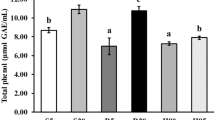Abstract
The furan levels in commercial coffee product samples (17 instant coffees, 12 mixed coffee, 8 canned coffee) were 49–2155, 10–201 and 15–209 ng/g, respectively. Since thermal degradation/rearrangement of carbohydrates is the main source of furan, the concentrations of furan and monosaccharides (mannose, rhamnose, glucose, galactose and arabinose) were analysed in 26 green and roasted coffee bean (Coffea arabica) varieties. In coffee beans, furan levels ranged from 4.71 (Bourbon Cerrado, Brazil) to 8.63 mg/kg (San Vicente, Honduras). Galactose was the main monosaccharide in green beans, followed by arabinose, glucose, mannose and rhamnose, on average. Roasting decreased the glucose content by about 81%, and arabinose decreased about 27% in all coffee beans. Glucose decreased the greatest after roasting and is thereby considered the major contributor to the formation of furan.
Similar content being viewed by others
References
Altaki M, Santos F, Galceran M (2007) Analysis of furan in foods by headspace solid-phase microextraction–gas chromatography–ion trap mass spectrometry. J Chromatogr A 1146(1):103–109
Cha J, Debnath T, Lee K-G (2019) Analysis of α-dicarbonyl compounds and volatiles formed in Maillard reaction model systems. Sci Rep 9(1):1–6
Chain EPOCITF, Knutsen HK, Alexander J, Barregård L, Bignami M, Brüschweiler B, Ceccatelli S, Cottrill B, Dinovi M, Edler L (2017) Risks for public health related to the presence of furan and methylfurans in food. EFSA J 15(10):e05005
Crews C, Castle L (2007) A review of the occurrence, formation and analysis of furan in heat-processed foods. Trends Food Sci Technol 18(7):365–372
EFSA (2011) Update on furan levels in food from monitoring years 2004–2010 and exposure assessment. EFSA J 9(9):2347
Food U, Administration D (2004) Exploratory data on furan in food. FDA, Washington, DC (May 7, 2004, updated June 7, 2004, June 15, 2005 and October 27, 2006. http://www.cfscanfda.gov/about~dms/furandat.htm1)
Guenther H, Hoenicke K, Biesterveld S, Gerhard-Rieben E, Lantz I (2010) Furan in coffee: pilot studies on formation during roasting and losses during production steps and consumer handling. Food Addit Contam 27(3):283–290
Han J, Kim MK, Lee KG (2017) Furan levels and sensory profiles of commercial coffee products under various handling conditions. J Food Sci 82(11):2759–2766
IARC (1995) Furan. IARC Monogr Eval Carcinog Risks Hum 63:393–407
Jeong SY, Jang HW, Debnath T, Lee KG (2019) Validation of analytical method for furan determination in eight food matrices and its levels in various foods. J Sep Sci 42(5):1012–1018
Kuballa T, Stier S, Strichow N (2005) Furan concentrations in coffee and coffee beverages. Dtsch Lebensm-Rundsch 101(6):229–235
Lee SJ, Kim MK, Lee K-G (2017) Effect of reversed coffee grinding and roasting process on physicochemical properties including volatile compound profiles. Innov Food Sci Emerg Technol 44:97–102
Limacher A, Kerler J, Davidek T, Schmalzried F, Blank I (2008) Formation of furan and methylfuran by Maillard-type reactions in model systems and food. J Agric Food Chem 56(10):3639–3647
Maga JA, Katz I (1979) Furans in foods. Crit Rev Food Sci Nutr 11(4):355–400
Mesías M, Guerra-Hernández E, García-Villanova B (2013) Furan content in Spanish baby foods and its relation with potential precursors. CyTA J Food 11(1):1–6
Nie S-P, Huang J-G, Zhang Y-N, Hu J-L, Wang S, Shen M-Y, Li C, Marcone MF, Xie M-Y (2013a) Analysis of furan in heat-processed foods in China by automated headspace gas chromatography–mass spectrometry (HS–GC–MS). Food Control 30(1):62–68
Nie S, Huang J, Hu J, Zhang Y, Wang S, Li C, Marcone M, Xie M (2013b) Effect of pH, temperature and heating time on the formation of furan in sugar–glycine model systems. Food Sci Hum Wellness 2(2):87–92
Owczarek-Fendor A, De Meulenaer B, Scholl G, Adams A, Van Lancker F, Eppe G, De Pauw E, Scippo M-L, De Kimpe N (2012) Furan formation in starch-based model systems containing carbohydrates in combination with proteins, ascorbic acid and lipids. Food Chem 133(3):816–821
Pavesi Arisseto A, Vicente E, Soares Ueno M, Verdiani Tfouni SAI, De Figueiredo Toledo MCl (2011) Furan levels in coffee as influenced by species, roast degree, and brewing procedures. J Agric Food Chem 59(7):3118–3124
Perez Locas C, Yaylayan VA (2004) Origin and mechanistic pathways of formation of the parent furan A food toxicant. J Agric Food Chem 52(22):6830–6836
Seok Y-J, Lee K-G, Biotechnology (2020) Analysis of furan in semi-solid and paste type foods. J Food Sci 29(2):293–301
Waizenegger J, Winkler G, Kuballa T, Ruge W, Kersting M, Alexy U, Lachenmeier D (2012) Analysis and risk assessment of furan in coffee products targeted to adolescents. Food Addit Contam Part A 29(1):19–28
Acknowledgements
This research was supported by the Korea Institute of Planning and Evaluation for Technology in Food, Agriculture, Forestry and Fisheries (IPET 118012031SB010); the Agriculture, Food and Rural Affairs Research Centre Support Program, through the Ministry of Agriculture, Food and Rural Affairs; and the Basic Science Research Program through the National Research Foundation of Korea (NRF 018R1A2B6002634).
Author information
Authors and Affiliations
Corresponding author
Additional information
Publisher's Note
Springer Nature remains neutral with regard to jurisdictional claims in published maps and institutional affiliations.
Rights and permissions
About this article
Cite this article
Kim, YJ., Choi, J., Lee, G. et al. Analysis of furan and monosaccharides in various coffee beans. J Food Sci Technol 58, 862–869 (2021). https://doi.org/10.1007/s13197-020-04600-5
Revised:
Accepted:
Published:
Issue Date:
DOI: https://doi.org/10.1007/s13197-020-04600-5




